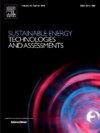Understanding savonius turbine wake for 2-D and 3-D simulations: proper orthogonal decomposition of velocity components
IF 7
2区 工程技术
Q1 ENERGY & FUELS
Sustainable Energy Technologies and Assessments
Pub Date : 2025-06-10
DOI:10.1016/j.seta.2025.104399
引用次数: 0
Abstract
Savonius turbines, known for their low cost and ease of maintenance, are widely used as small-scale wind and hydrokinetic turbines. However, significant discrepancies exist between two-dimensional (2-D) and three-dimensional (3-D) computational fluid dynamics (CFD) simulations, particularly in predicting wake dynamics. This study investigates wake characteristics across varying tip speed ratios (TSRs) using proper orthogonal decomposition (POD) of velocity components from 3-D simulations. POD analysis reveals that for TSR ≤ 1.0, vortex shedding from blade tips dominates, whereas for TSR > 1.0, rotational motion becomes more prominent, followed by vortex shedding. The vertical velocity component shows dominant POD modes at the rotational frequency and its harmonics, while the streamwise and lateral components are primarily influenced by the vortex shedding frequencies. These dynamics are absent in 2-D simulations due to the lack of vortex stretching in the third direction, leading to fundamentally different modal structures. Additionally, results show vertical transport is critical to wake recovery, significantly outweighing lateral transport up to two rotor diameters downstream—an effect not captured in 2-D simulations. Since accurate wake modelling is essential for predicting the performance of Savonius turbine arrays, especially in streamwise configurations, the limitations of 2-D simulations pose a challenge. This study provides physical insights into the origins of those limitations and highlights the necessity of 3-D simulations for reliable prediction of array power coefficients. The findings also serve as a foundation for future development of reduced-order models for low-cost array simulations.
理解萨伏纽斯涡轮尾流的二维和三维模拟:适当的正交速度分量分解
Savonius涡轮机以其低成本和易于维护而闻名,被广泛用于小型风力和水动力涡轮机。然而,二维(2-D)和三维(3-D)计算流体动力学(CFD)模拟之间存在显著差异,特别是在预测尾流动力学方面。本文利用三维仿真中速度分量的正交分解(POD)研究了不同叶尖速比(tsr)的尾迹特性。POD分析表明,TSR≤1.0时,叶尖涡脱落占主导地位,而TSR >;1.0,旋转运动更加突出,其次是旋涡脱落。垂直速度分量在旋转频率及其谐波上表现出主导的POD模式,而流向和横向分量主要受涡脱落频率的影响。由于缺乏第三方向的涡旋拉伸,这些动力学在二维模拟中是不存在的,导致了根本不同的模态结构。此外,研究结果还表明,垂直输送对尾流恢复至关重要,显著超过下游两个转子直径的横向输送,这在二维模拟中没有得到体现。由于精确的尾迹建模对于预测萨沃纽斯涡轮阵列的性能至关重要,特别是在流向配置中,因此二维模拟的局限性提出了挑战。这项研究为这些限制的起源提供了物理见解,并强调了三维模拟对阵列功率系数可靠预测的必要性。这些发现也为未来低成本阵列模拟的降阶模型的发展奠定了基础。
本文章由计算机程序翻译,如有差异,请以英文原文为准。
求助全文
约1分钟内获得全文
求助全文
来源期刊

Sustainable Energy Technologies and Assessments
Energy-Renewable Energy, Sustainability and the Environment
CiteScore
12.70
自引率
12.50%
发文量
1091
期刊介绍:
Encouraging a transition to a sustainable energy future is imperative for our world. Technologies that enable this shift in various sectors like transportation, heating, and power systems are of utmost importance. Sustainable Energy Technologies and Assessments welcomes papers focusing on a range of aspects and levels of technological advancements in energy generation and utilization. The aim is to reduce the negative environmental impact associated with energy production and consumption, spanning from laboratory experiments to real-world applications in the commercial sector.
 求助内容:
求助内容: 应助结果提醒方式:
应助结果提醒方式:


